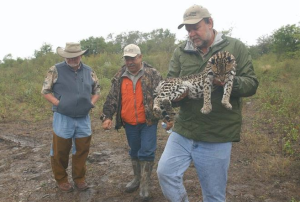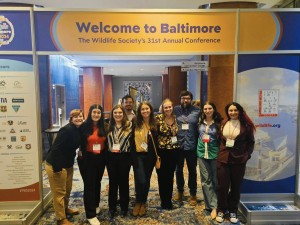
About Us

Wild cat research at the Caesar Kleberg Wildlife Research Institute (CKWRI) was initiated by Regents Professor Dr. Michael Tewes in 1981. Today, he continues his feline research activities into the 21st century. Dr. Lisanne Petracca, Assistant Professor of Carnivore Ecology, joined the program in January 2023. She leads the Spatial and Population Ecology of Carnivores (SPEC) Labat CKWRI.
A long-term project focusing on the ocelot began in 1981 and represented the first research of this feline anywhere within the Western Hemisphere. The achievements and recognition of this study provided the basis for research expansion into many areas, including cat ecology, behavior, social organization, genetics, disease, parasitology, biogeography, human dimensions, and population parameter estimation. These research projects are continuing today.

The Feline Research Program initially focused on cat research in South Texas. Subsequently, the program has expanded to include several cat species in various regions throughout the world.
Of the 40 species of wild cats existing today, this Program has studied 12 different cat species, including the ocelot, jaguarundi, margay, bobcat and mountain lion in Texas and Mexico, the clouded leopard, golden cat, marbled cat and leopard cat in Southeast Asia, and the leopard in Africa. In addition, Dr. Petracca’s past work includes research on African lion, leopard, jaguar, and güiña (a small cat in Chile).
Knowledge generated from the Feline Research Program has been far-reaching. It has produced a significant beneficial impact in the study of wild cat biology and conservation with over 94 scientific articles and 236 technical presentations at scientific conferences. The Feline Research Program has successfully secured $19.6 million in research grants provided by various sources. Long-term private support of the Feline Research Program has been graciously given by Tim and Karen Hixon, Frank and Mary Yturria, Ben F. Vaughan, III and Michael Corbett.

Public outreach is an important activity of the Feline Research Program. Because wild cats tend to attract public interest, the Program has served as a vehicle to distribute information and educational opportunities which further galvanizes public support for the conservation of wild cats. To serve this effort, the Feline Research Program has delivered many visual presentations and popular articles to various audiences.
Another critical dimension of the Feline Research Program is the development of future scientists and biologists who will undertake the emerging environmental challenges confronting our society. The Feline Research Program has developed an international reputation that attracts students from around the world. Researchers participating in the Feline Research Program have developed into several important conservation roles in the U.S., including policy development in the White House and U.S. Senate, and furbearer biologists for state wildlife agencies. Past students have played pivotal roles in the recovery of the Florida panther, achieved professor and department chair of a wildlife department, and served as lead recovery biologists for the federal and state endangered ocelot programs.

Although the large majority of cat research has occurred in the Tamaulipan Biotic Province of southern Texas and northern Mexico, the impact of the Feline Research Program has yielded global contributions. Past students have moved on to study leopards in Africa, jaguar and margay in Mexico, snow leopards in India and China, several rare cats in Thailand, and civet cats in Taiwan. Other former students have served with nonprofit conservation organizations from Texas to Cambodia.
The Feline Research Program has made important contributions in the discovery of biological and conservation information about wild cats, and the development of our future biologists. These contributions have benefitted not only the people of Texas, but the resources and citizens of the world.